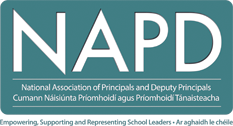Joint Communication
As the professional organisations for post-primary school leaders (NAPD), primary school leaders (IPPN), and parents of primary and post-primary students (NPC), we have a shared commitment to ensure that the needs of the students are at the centre of every decision that is made and to deliver the most effective school experience for all.
Since Circulars 0002/2024 & 0003/2024 issued in early February, detailing the revised model for Special Education Allocations to schools, there has been much commentary and analysis, some of which has been inaccurate. The misconceptions that have arisen, as a result, have caused significant concern and anxiety among parents and in schools. The purpose of this joint communication is to address those misconceptions and allay those concerns.
As education stakeholders, and on behalf of our respective members, we engaged in a process of consultation with the Department of Education (DE) around SET allocations for the 2024/25 academic year. We were given an opportunity to provide perspectives on the proposed model and account was taken of those perspectives in the circulars that issued to schools. Consultation with our respective members elicited concerns about the consistency and accuracy of the data that was being used to inform those allocations.
It is important to be clear that children with complex needs have not been excluded from the allocation of hours that schools received. As stakeholders, we work to ensure that the needs of all children are met and we would not support or welcome any model that proposed a decrease in supports for children with complex needs.
The DE changed how it calculates complex needs because there is no consistent, accurate and up-to-date external data across the country in relation to children with complex needs. Crucially, a school's previous allocation for complex needs has been protected and is now spread across the allocations model. If the data previously used in the model to identify complex needs was used in 2024, most schools would have received a lesser allocation of hours.
It is also important to be clear that the change in how complex needs is identified in the model does not mean that children with complex needs are not accounted for and are not supported by the model. Children with complex needs should receive the greatest level of support from within the quantum of hours that the school was allocated - nothing has changed in this regard. We continue to advocate for high quality therapeutic services in schools to support students, in particular from bodies such as the Children’s Disability Network Teams, who have responsibilities to support young people.
Given that the revised allocations model is now underpinned by more accurate data provided by schools, it is hoped that the quantum of hours allocated to schools will better enable children with additional and complex needs to achieve and thrive in their mainstream settings.
The equal treatment of girls and boys within the model is welcome as is the move to an annualised model rather than one that changed every 2 to 3 years. This should mean greater consistency and stability for schools in terms of their allocations. It should also ensure greater sensitivity to changes in an individual school’s enrolment and educational teaching needs’ profile.
While the revised model for SET Allocations is certainly not perfect, it is important to note that the DE has acknowledged that this is the beginning of a process of reform. The circulars state clearly that the review of the SET Allocations model identified ‘that a programme of continuous development was required to ensure that the model was delivering effectively, both in supporting the changing needs in the education system, and for individual schools. The journey of enhancement begins with the 2024/25 allocation… ’.
As stakeholders, we continue to advocate for a greater quantum of resources to be allocated nationally and for more current enrolments to be used for schools with developing status. We also believe that the model should include a buffer to ensure emerging needs can be addressed in a timely manner. We note the intention to provide a more streamlined process of review and we continue to advocate for enhanced collaboration between the SENO and the school.
Of particular interest is the section in the circulars which details progression to a stage where “schools have more input into identifying the need in their school”. We believe that a move to such a high-trust model of self-declaration would, over time, be the most effective and efficient way to ensure that schools were resourced adequately to meet the additional needs of children.
Is sinne le meas,
Áine Lynch Paul Crone Páiric Clerkin
CEO NPC Director NAPD CEO IPPN
_________________________________________________________________________
Copyright (C) 2024 National Association of Principals and Deputies. All rights reserved.

